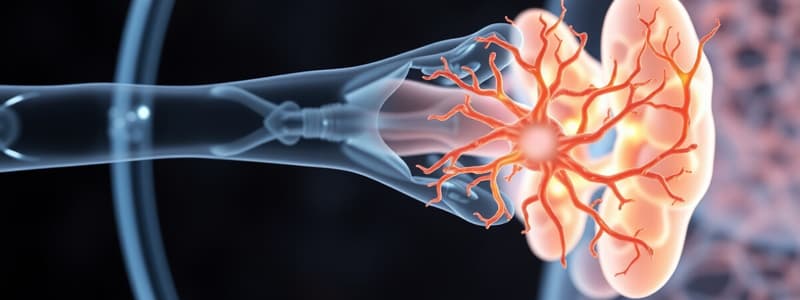Podcast
Questions and Answers
Where does gas exchange occur?
Where does gas exchange occur?
Gas exchange occurs within the lower airways, primarily the alveoli.
Alveoli are managed by the pressure changes that occur during ventilation.
Alveoli are managed by the pressure changes that occur during ventilation.
True (A)
At what level does respiration occur?
At what level does respiration occur?
Cellular level
What phenomenon occurs when air gets trapped in the lungs?
What phenomenon occurs when air gets trapped in the lungs?
What is required for the act of inspiration?
What is required for the act of inspiration?
What is the term for the air that remains in the lungs after exhalation?
What is the term for the air that remains in the lungs after exhalation?
What happens to the alveoli at the apex of the lungs compared to the base?
What happens to the alveoli at the apex of the lungs compared to the base?
Flashcards are hidden until you start studying
Study Notes
Gas Exchange Overview
- Gas exchange primarily occurs in the alveoli, the functional units of respiration.
- Blood entering the lungs through the pulmonary artery is deoxygenated and becomes oxygenated in the capillaries surrounding alveoli before returning via the pulmonary vein.
Alveoli Management
- Alveoli are influenced by pressure changes during ventilation; higher pressures facilitate the opening of more alveoli, while lower pressures can cause alveoli to remain closed.
Cellular Respiration
- Respiration occurs at the cellular level, not in the air that is inspired, which consists of a mixture of O2 and CO2.
- Ventilation rate measures the frequency of breaths, while conditions like fluid buildup or fibrosis reduce gas exchange efficiency.
Gas Trapping
- Air trapping is a condition where inhaled air cannot be fully exhaled, commonly seen in obstructive lung diseases like asthma.
- Symptoms include chest heaviness or breathlessness, which can range from mild to severe; severe cases may lead to progressive difficulty in breathing.
- Air trapping can result from mucus obstruction or loss of airway elasticity, typical in conditions like emphysema and COPD.
Normal Respiration
- Inspiration is an active process involving the diaphragm, which contracts to expand the lungs and create a vacuum for air intake.
- Expiration is predominantly passive unless obstructive diseases are present; affected individuals must exert extra effort to exhale due to airway resistance.
Residual Volume vs. Air Trapping
- Residual volume is the amount of air left in the lungs after full exhalation, essential for preventing lung collapse and enabling re-inflation of the lungs.
- Air trapping is considered abnormal, whereas residual volume is normal and necessary for lung function.
Zones of West
- Blood flow distribution in the lungs varies; more blood flows to the base than the apex due to gravity and vascular resistance.
- Upper alveoli are more inflated and have a different airflow pattern than lower alveoli, ensuring proper ventilation-perfusion matching for optimal oxygenation in the blood.
Studying That Suits You
Use AI to generate personalized quizzes and flashcards to suit your learning preferences.



